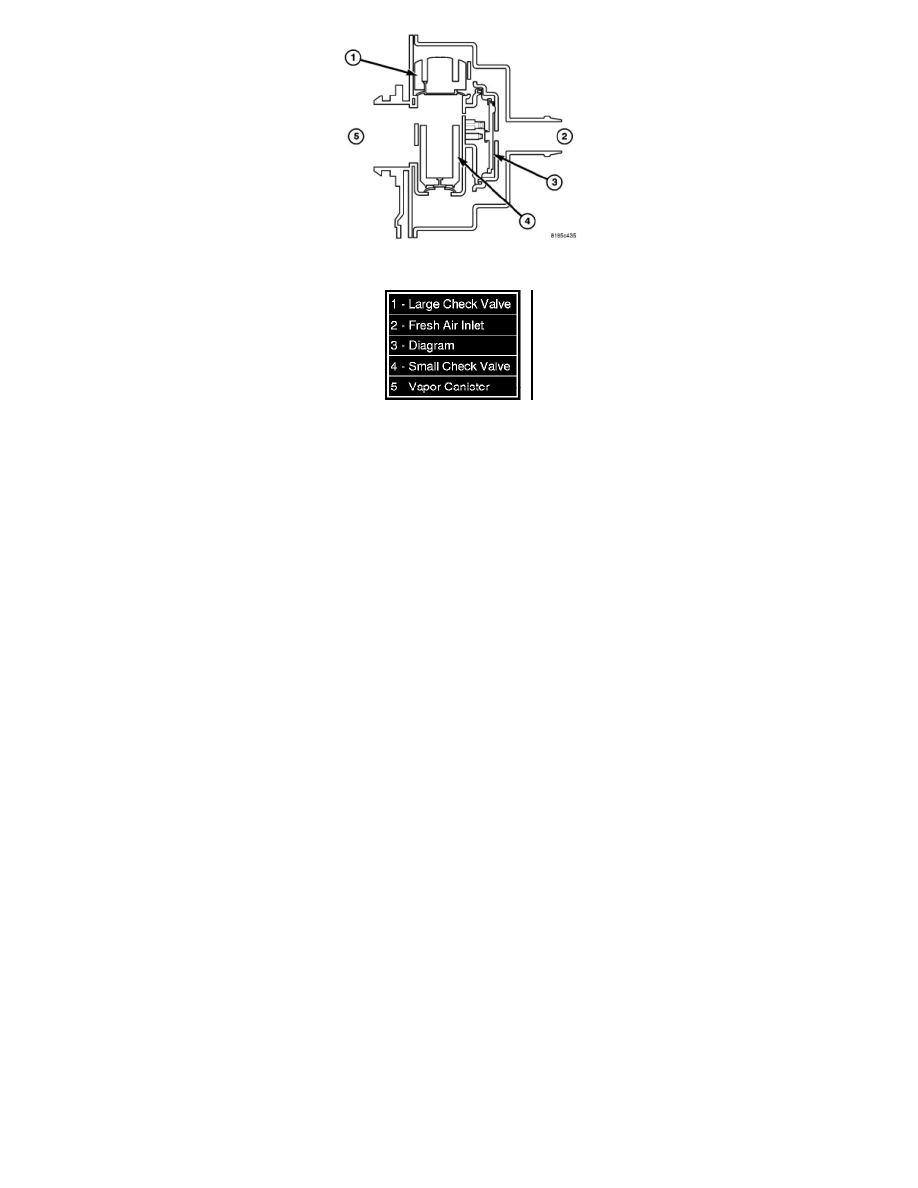Dakota 4WD V8-4.7L Flex Fuel (2008)

CUT AWAY OF MODULE
The ESIM (Evaporative System Integrity Monitor), while physically different than the NVLD system, performs the same basic function as the NVLD
does - controlling evaporative emissions. The ESIM has been simplified because the solenoid used on the NVLD is not used on the ESIM.
The ESIM consists of housing, two check valves (sometimes referred to as weights), a diaphragm, a switch and a cover. The larger check valve seals for
pressure and the smaller one seals for vacuum.
During refueling, pressure is built up in the evaporative system. When pressure reaches approximately.5 inches of water, the large check valve unseats
and pressure vents to the fresh air filter.
Conversely, when the system cools, and the resulting vacuum lifts the small check valve from its seat and allows fresh air to enter the system and relieves
the vacuum condition. When a calibrated amount of vacuum is achieved in the evaporative system, the diaphragm is pulled inward, pushing on the spring
and closing the contacts.
The ESIM conducts test on the evaporative system as follows: An engine off, non-intrusive test for small leaks and an engine running, intrusive test for
medium/large leaks.
The ESIM weights seal the evap. system during engine off conditions. If the evap. system is sealed, it will be pulled into a vacuum, either due to the cool
down from operating temperature or diurnal ambient temperature cycling. When the vacuum in the system exceeds about 1" H20, the vacuum switch
closes. The switch closure sends a signal to the PCM. In order to pass the non-intrusive small leak test, the ESIM switch must close within a calculated
amount of time and within a specified amount of key-off events.
If the ESIM switch does not close as specified, the test is considered inconclusive and the intrusive engine running test will be run during the next key-on
cycle. This intrusive test will run on the next cold engine running condition.
Conditions for running the intrusive test are:
-
After the vehicle is started, the engine coolant temperature must be within 50°F (10°C) of ambient to indicate a cold start.
-
The fuel level must be between 12% and 88%.
-
The engine must be in closed loop.
-
Manifold vacuum must be greater than a minimum specified value.
-
Ambient temperature must be between 39°F and 98°F (4°C and 37°C) and the elevation level must be below 8500 feet (2591 meters).
The test is accomplished by the PCM activating the purge solenoid to create a vacuum in the evaporative system. The PCM then measures the amount of
time it takes for the vacuum to dissipate. This is known as the vacuum decay method. If the switch opens quickly a large leak is recorded. If the switch
opens after a predetermined amount of time, then the small leak matures. If the switch does not close, then a general evaporative failure is recorded. The
purge monitor tests the integrity of the hose attached between the purge valve and throttle body/intake. The purge monitor is a two stage test and it runs
only after the evaporative system passes the small leak test.
Even when all of the thresholds are met, a small leak won't be recorded until after the medium/large leak monitor has been run. This is accomplished by
the PCM activating the purge solenoid to create a vacuum in the evaporative system. The PCM then measures the amount of time it takes for the vacuum
to dissipate. This is known as the vacuum decay method. If the switch opens quickly a large leak is recorded. If the switch opens after a predetermined
amount of time, then the small leak matures. If the medium/large leak test runs and the ESIM switch doesn't close, a general evaporative test is run. The
purge solenoid is activated for approximately 10 seconds, increasing the amount of vacuum in the system. If the ESIM switch closes after the extended
